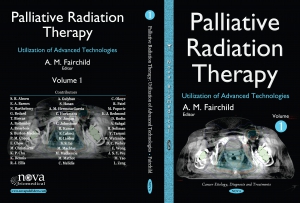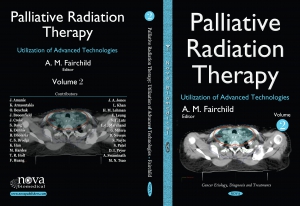Single versus multiple session stereotactic body radiotherapy for spinal metastasis: the risk-benefit ratio.
Single versus multiple session stereotactic body radiotherapy for spinal metastasis: the risk-benefit ratio.
Redmond KJ, Sahgal A, Foote M, Knisely J, Gerszten PC, Chao ST, Suh JH, Sloan AE, Chang EL, Machtay M, Lo SS.
Future Oncol. 2015;11(17):2405-15. doi: 10.2217/fon.15.160. Epub 2015 Sep 15.
PMID: 26369361
Veterans Healthcare Administration (VHA) National Palliative Radiotherapy Taskforce Update
The Veterans Healthcare Administration (VHA) National Palliative Radiotherapy Taskforce formed in 2012 with the aim of researching and advancing palliative care within the VHA. The taskforce has since expanded and made meaningful progress. Through a series of survey studies, the group has measured practice patterns across the 39 (soon to be 40) VHA facilities that provide radiation therapy to Veterans with cancer at the end of life. Efforts have focused on evaluating prescriptions that are preferred for the palliation of bone metastases, spinal cord compression, and brain metastases. Studies have also evaluated the availability of palliative care services and advanced radiation technologies within the VHA for management of both palliative and definitive cases. A number of abstracts and papers have resulted from this work:
- Gutt et al. “Management of Metastatic Spinal Cord Compression among Veterans Health Administration Radiation Oncologists.” American Society for Therapeutic Radiation Oncology, San Antonio, TX, Oct 2015. Int J Rad Oncol Biol Phys, 2015 Nov; 93(3):E475-476.
- Dawson et al. “A cross-sectional view of radiation fractionation schemes used in the treatment of painful bone metastases (PBM) cases within the Veterans Health Administration Radiation Oncology Centers.” Palliative Care in Oncology Symposium, Boston, MA, Oct 2015. J Clin Oncol 33, 2015 (suppl 29S;abstr 177).
- Dawson et al. “Radiotherapeutic Care within the Veterans Health Administration of US Veterans with Metastatic Cancer to the Brain: Supportive Measures (Part 1 of 2 reports).” American Radium Society, Kauai, HI, May 2015. Oncology. April 2015, Vol. 29; Supplement 1. Page 78 (Poster 118).
- Cheuk et al. “Radiotherapeutic Care within the Veterans Health Administration of US Veterans with Metastatic Cancer to the Brain: Part 2 Clinical Treatment Patterns.” American Radium Society, Kauai, HI, May 2015. Oncology. April 2015, Vol. 29; Supplement 1. Page 76 (P114).
- Gutt et al. “The role of Palliative Radiotherapy in the Management of Metastatic Cancer: Bone Metastases, Brain Metastases, and Spinal Cord Compression.” May 2015;32:5(suppl 4):12S-16S.
- Moghanaki et al. “Availability of Single Fraction Palliative Radiotherapy for Cancer Patients Receiving End-of-Life Care within the Veterans Healthcare Administration.” J Pall Med. Nov 2014;17(11):1221-5.
- Dawson et al. “The Availability of and Satisfaction with Palliative Care Services among Veterans Health Administration (VHA)-Based Radiation Oncologists.” Palliative Care in Oncology Symposium, Boston, MA, Oct 2014. J Clin Oncol 32, 2014 (suppl 31;abstr 55).
- Dawson et al. “Advanced Radiation Oncology Technology within the Veterans Health Administration (VHA).” American Society of Clinical Oncology Quality Care Symposium, Boston, MA, Oct 2014. J Clin Oncol 32, 2014 (suppl 30;abstr 52).
- Moghanaki et al. “Availability of Single Fraction Palliative Radiotherapy for Cancer Patients Receiving End-of-Life Care within the Veterans Healthcare Administration.” American Radium Society, St Thomas, USVI, April 2014.
Looking ahead, a particular interest of this group is to increase awareness of the availability and appropriateness of hypofractionated radiotherapy for palliation to optimize patient comfort and convenience. A hope is that the effort of this group can help improve quality of care for both patients treated within the VHA and for terminal cancer patients in general. We look forward to new efforts in 2016 and increased collaboration with SPRO members working towards similar goals.
Drew Moghanaki
Ruchika Gutt
George Dawson
Alice Cheuk
SPRO Annual Meeting 2015 at ASTRO in San Antonio
On October 18, the Society for Palliative Radiation Oncology (SPRO) held its annual meeting in San Antonio, TX, in conjunction with the American Society for Radiation Oncology (ASTRO) annual meeting. Dr. Stephen Lutz welcomed everyone to the meeting and reviewed the initiatives that have been undertaken since SPRO was formally introduced one year before. He then introduced speakers in three categories: Research, Education, and Advocacy.
For clinical research, Dr. Chad Tang from MD Anderson presented the Prognostic Index for Spine Metastases (PRISM), a measure that aims to categorize patients with excellent or poor prognosis following stereotactic spine radiosurgery and to help identify the rationale for single or multiple fraction regimens. The PRISM score categorizes gender, Karnofsky Performance Score, prior surgery, previous radiotherapy to the affected site, number of organ system involved with metastasis, solitary versus multiple spine metastases, and time from diagnosis to discovery of metastasis. The PRISM model allows for stratification of metastatic patients with poor and excellent survival after SSRS. Group 4, with the worst prognosis, had median survival of 9.1 months after SSRS treatment. Groups 3 and 2 achieved median survival of 22.2 months and 32.4 months, respectively. Group 1, with the most favorable prognosis, showed the best survival with 65% of the patients living more than 60 months after treatment. Dr. Tang invited suggestions and collaborative data accrual from experts at other radiotherapy centers.
In the education section of the meeting, Dr. Randy Wei from UC Irvine presented preliminary survey results of radiation oncology residency directors regarding their thoughts about palliative care training within radiation oncology residency programs. Approximately, 70% of US Residencies have formal palliative care curriculum. Still, 36% 36% of programs offer no instruction recognizing when to stop or not start radiation therapy in end of life patients. The survey is to be completed by the end of 2015 with plans for publication in early 2016.
Dr. Drew Moghanaki from Virginia Commonwealth University and Hunter Holmes McGuire VA Medical Center presented palliative radiotherapy advocacy efforts within the veterans’ system. He described a predicament that veterans face when they enroll in hospice, namely that they lose their VA benefits and become ineligible for palliative radiation treatment. Dr. Mognahaki and his colleagues have begun an effort to allow for the provision of radiotherapy for veterans who have been admitted to hospice, with the additional goal of creating a model for similar patterns of care in civilian hospitals.
Following the presentations, small working groups brainstormed ideas for further improvements in palliative oncology care. One of the initiatives that garnered the most interest was the need for a greater push towards including palliative care questions on national board exams for radiation oncology. Furthermore, the group declared its support for both the formation of palliative radiotherapy clinical services in tertiary care centers as well as improved collaboration with palliative care services in hospitals throughout the United States.
Palliative Radiation Therapy: Utilization of Advanced Technologies
Palliative Radiation Therapy: Utilization of Advanced Technologies.
Both volumes should be published in Q3 2015 and the links to volume 1 and volume 2 are here:
The Care Planning Act of 2015
We are looking for input some verbiage regarding the specific usefulness of palliative radiotherapy to put into the Care Planning Act of 2015. Please feel free to review the PDF downloads.






